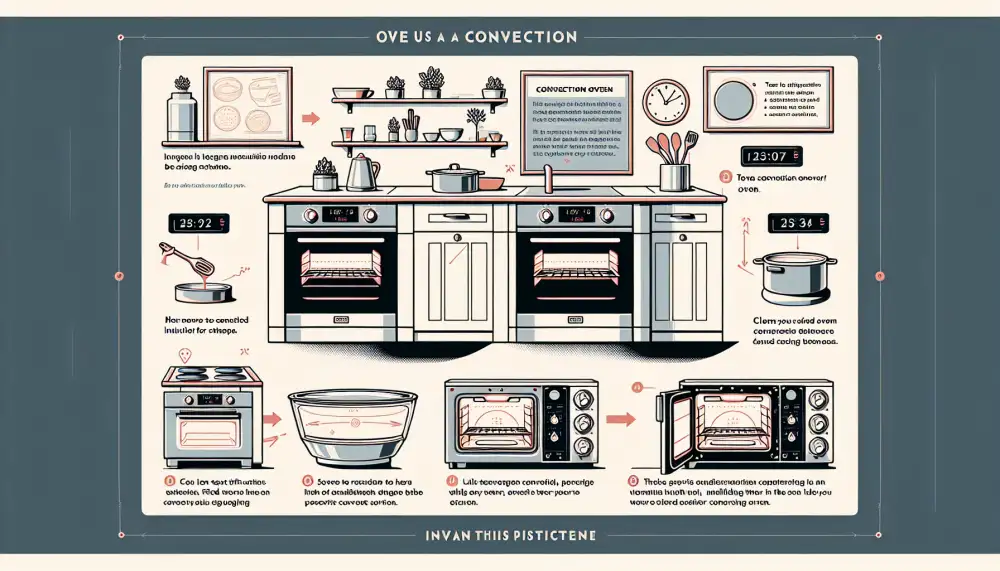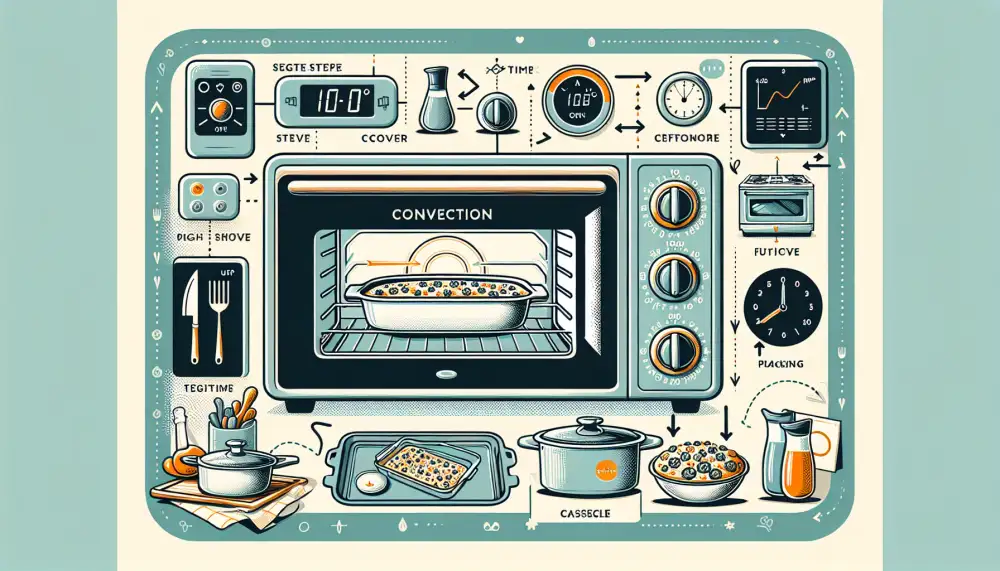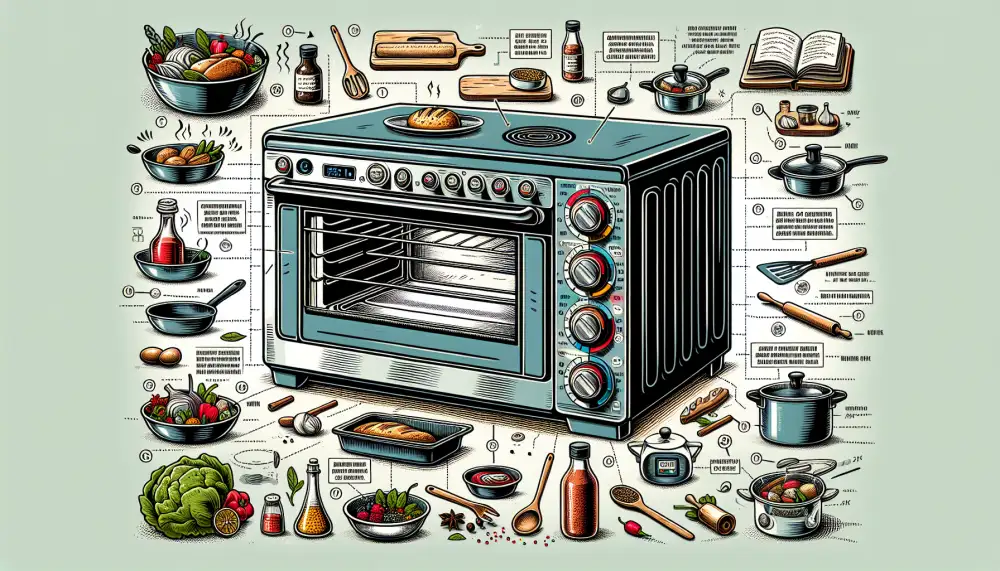Master Your Convection Oven: A Quick-Start Guide for Delicious Results

Understanding Convection Ovens
Preheat Your Oven ProperlyPreheating is crucial for any oven, but it's especially important with convection ovens. Convection ovens cook faster than conventional ovens because of the fan that circulates hot air. Starting with a preheated oven ensures that the circulating air is already at the desired temperature when you put your food in. This helps to ensure even cooking and prevents your food from drying out. Always consult your oven's manual for the recommended preheating time, as it can vary depending on the model and the desired temperature. For most convection ovens, a preheating time of 10-15 minutes is sufficient. You can usually tell when your oven is preheated when the indicator light turns off or you hear a beep. Some ovens may also display the current temperature.
Adjust Temperature Accordingly
One of the biggest advantages of a convection oven is its ability to cook food more evenly and quickly than a conventional oven. However, because a convection oven circulates hot air, you may need to adjust the cooking temperature or time for optimal results. A general rule of thumb is to reduce the recipe's recommended temperature by 25°F when using a convection setting. So, if your recipe calls for 400°F, you'd set your convection oven to 375°F. This adjustment helps prevent over-browning and ensures your food is cooked through properly.
Keep in mind that this temperature reduction is a guideline, and some recipes may require different adjustments. It's always a good idea to consult the recipe instructions or a convection oven cooking chart for specific recommendations. As you become more familiar with your convection oven, you'll develop a better sense of how much to adjust the temperature for different dishes. Don't be afraid to experiment and take notes on your results to fine-tune your convection cooking skills.
Use Recommended Cookware
When cooking with a convection oven, it's important to use cookware that allows for proper airflow. Convection ovens work by circulating hot air throughout the cavity, and using the right cookware can help maximize this airflow for even cooking.
Avoid using cookware that is too large or bulky, as it can block the flow of hot air. Opt for cookware that is made from materials that conduct heat well, such as aluminum or stainless steel. Dark-colored cookware can also help absorb heat more efficiently.
Consider using cookware with low sides or rims, as this will allow the hot air to circulate more easily around your food. For optimal results, use baking sheets with a shallow rim or with perforations to allow for maximum airflow.
Remember that glass or ceramic cookware may require longer cooking times in a convection oven, as these materials do not conduct heat as efficiently as metal. Adjust cooking times and temperatures accordingly. By using the right cookware, you can help ensure that your food cooks evenly and efficiently in your convection oven.

Don't Overcrowd the Oven
One of the biggest mistakes people make when using a convection oven is overcrowding it. When you overcrowd the oven, the hot air can't circulate properly. This can lead to uneven cooking, with some foods being undercooked and others being overcooked.
To ensure proper airflow, give your food some breathing room. If you're cooking multiple dishes at once, use different racks and leave at least an inch or two between them. Also, avoid using baking sheets that are too large for your oven.
Here's a helpful tip: If you're not sure whether or not your oven is overcrowded, try this simple test. Turn on the oven light and look inside. If you can see all of the food clearly, then you're good to go. If not, you may need to rearrange things or cook in batches.
Remember, a little bit of space goes a long way in a convection oven. By avoiding overcrowding, you can ensure that your food cooks evenly and deliciously every time.
"None"
Name Surname
Consider Reduced Cooking Times
One of the biggest advantages of a convection oven is its ability to cook food faster than a conventional oven. This is because the circulating hot air cooks food more evenly and efficiently. When using a convection oven, it's generally recommended to reduce cooking times by 25% or lower the cooking temperature by 25 degrees Fahrenheit. For example, if a recipe calls for baking a dish at 400 degrees Fahrenheit for 30 minutes in a conventional oven, you would bake it at 375 degrees Fahrenheit for 22-25 minutes in a convection oven.
| Feature | Conventional Oven | Convection Oven |
|---|---|---|
| Heating Method | Radiant heat from bottom element | Fan-circulated hot air |
| Cooking Time | Standard recipe times | Reduce recipe times by 25% or lower temperature by 25°F (14°C) |
| Food Browning | Can be uneven due to hot spots | More even browning due to consistent heat distribution |
| Best Uses | Baking cakes, casseroles, roasting large cuts of meat | Roasting meats, baking cookies, crisping food surfaces |
However, it's important to keep in mind that not all recipes require the same adjustments. Some recipes may require a shorter cooking time, while others may need a slightly longer cooking time. It's always a good idea to start with a shorter cooking time and check the food regularly to avoid overcooking. You can use a meat thermometer to check the internal temperature of meat and poultry, and a toothpick to check the doneness of cakes and muffins.

With a little practice and experimentation, you'll get the hang of adjusting cooking times and temperatures for your convection oven. You'll be able to enjoy perfectly cooked meals in less time.
Rotate Food for Even Cooking
Convection ovens are known for their ability to cook food more evenly than traditional ovens. This is because the fan circulates the hot air around the oven cavity, eliminating hot and cold spots. However, even with a convection oven, it's still important to rotate your food for the most even cooking possible.
Think about it: your food is stationary while the heat source (the circulating hot air) is constantly moving. This means that one side of your food might be exposed to more heat than the other. By rotating your food, you're ensuring that all sides are cooked evenly.
This is especially important for larger items like roasts, whole chickens, and casseroles. For example, if you're roasting a chicken, you'll want to rotate it 180 degrees halfway through the cooking time. This will help to ensure that both sides of the chicken are cooked evenly and have that beautiful golden-brown color.
For smaller items like cookies or muffins, you can usually get away with rotating the baking sheet halfway through cooking. This is because the smaller items will cook more quickly and evenly. However, if you're using a convection oven with a single heating element and fan located in the back, it's a good idea to rotate your pans from front to back to ensure even browning.
Remember that every oven is different, so it may take some trial and error to figure out the best way to rotate your food for optimal results. Don't be afraid to experiment and take notes on what works best for your oven and recipes.
Utilize Convection Roasting Features
Convection ovens are equipped with a fan that circulates hot air throughout the oven cavity. This even heat distribution helps to cook food more evenly and in less time than traditional ovens. When using the convection roasting feature, it's important to adjust your cooking time and temperature accordingly.
Start by reducing the oven temperature by 25°F from the recipe's recommendation for a conventional oven. This is because the circulating hot air cooks food more efficiently. Additionally, you can generally reduce the cooking time by about 25% as well. However, it's always a good idea to keep an eye on your food and use a meat thermometer to ensure it's cooked to the proper internal temperature.
Convection roasting is particularly beneficial for roasting meats, poultry, and vegetables. The circulating hot air helps to brown food more evenly and creates a crispy exterior while keeping the inside moist and tender. When roasting vegetables, toss them with a little oil and spread them out in a single layer on a baking sheet for optimal results. For meats and poultry, consider using a roasting rack to elevate them from the bottom of the pan, allowing the hot air to circulate around the entire surface.

Experiment with Baking Settings
Convection ovens are known for faster and more even cooking due to the circulating hot air. This is great for everything from roast chicken to cookies. But, getting the hang of the settings can take a little practice. Don't be afraid to experiment! Start by reducing the oven temperature by 25°F from what your recipe states. This helps prevent over-browning, a common issue when first using a convection oven.
For example, if a recipe for baking a cake calls for 350°F in a conventional oven, set your convection oven to 325°F. Keep a close eye on your food as it cooks, especially for the first few times. You might find that things cook faster than expected. Use the timer on the oven to remind yourself to check on your food earlier than the recipe suggests.
Try baking a simple sheet of cookies or roasting vegetables. These are easy to observe for even browning and doneness. As you get more comfortable, you can experiment with more complex dishes. Remember, every oven is different, so keep a note of any adjustments you make and the results you achieve. This will help you fine-tune your convection cooking skills and get perfect results every time.
Clean Your Oven Regularly
A clean oven cooks better and lasts longer. That goes double for convection ovens. Built-up grease and food particles can affect airflow, leading to uneven cooking. Aim to clean your convection oven every 1-3 months, depending on how often you use it.
Start with a cool oven. Remove oven racks and any loose debris. Most convection ovens have a self-cleaning function – a huge time saver! If yours does, consult your manual for specific instructions. For manual cleaning, use a non-abrasive cleaner and a sponge or cloth. Avoid getting cleaner on the heating elements. For stubborn messes, let the cleaner sit for a few minutes before wiping. Don't forget to clean the oven door – both the inside and outside. Once clean, replace the racks and allow the oven to dry completely before using it again.
Published: 30. 06. 2024
Category: Food



